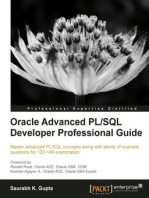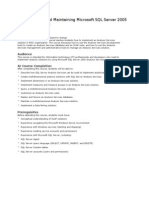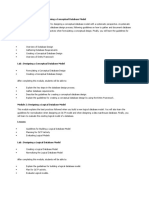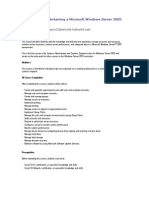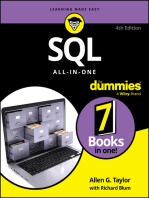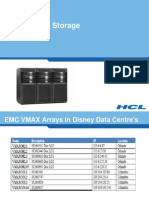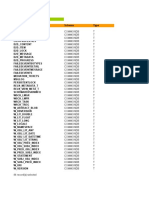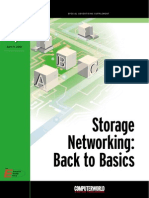Course 2778A:: Writing Queries Using Microsoft SQL Server 2008 Transact-SQL
Course 2778A:: Writing Queries Using Microsoft SQL Server 2008 Transact-SQL
Uploaded by
Chris GabbyCopyright:
Available Formats
Course 2778A:: Writing Queries Using Microsoft SQL Server 2008 Transact-SQL
Course 2778A:: Writing Queries Using Microsoft SQL Server 2008 Transact-SQL
Uploaded by
Chris GabbyOriginal Title
Copyright
Available Formats
Share this document
Did you find this document useful?
Is this content inappropriate?
Copyright:
Available Formats
Course 2778A:: Writing Queries Using Microsoft SQL Server 2008 Transact-SQL
Course 2778A:: Writing Queries Using Microsoft SQL Server 2008 Transact-SQL
Uploaded by
Chris GabbyCopyright:
Available Formats
Course 2778A:
Writing Queries Using Microsoft SQL Server 2008 Transact-SQL
About this Course This 3-day instructor led course provides students with the technical skills required to write basic TransactSQL queries for Microsoft SQL Server 2008. Audience Profile This course is intended for SQL Server database administrators, implementers, system engineers, and developers who are responsible for writing queries. Course Details Module 1: Getting Started with Databases and Transact-SQL in SQL Server 2008 The student will be introduced to how client/server architecture works, and examine the various database and business tasks that can be performed by using the components of SQL Server 2008. The student will also be introduced to SQL Server database concepts such as relational databases, normalization, and database objects. In addition, the student will learn how to use T-SQL to query databases and generate reports. Lessons
Overview of SQL Server 2008 Overview of SQL Server Databases Overview and Syntax Elements of T-SQL Working with T-SQL Scripts Using T-SQL Querying Tools Lab : Using SQL Server Management Studio and SQLCMD
Exploring the Components and Executing Queries in SQL Server Management Studio Starting and Using SQLCMD Generating a Report from a SQL Server Database Using Microsoft Office Excel After completing this module, students will be able to:
Describe the architecture and components of SQL Server 2008. Describe the structure of a SQL Server database. Explain the basics of the SQL language. Describe the syntax elements of T-SQL. Explain how to manage T-SQL scripts. Use T-SQL querying tools to query SQL Server 2008 databases. Module 2: Querying and Filtering Data The students will be introduced to the basic Transact-SQL (T-SQL) statements that are used for writing queries, filtering data, and formatting result sets. Lessons
Using the SELECT Statement Filtering Data
Working with NULL Values Formatting Result Sets Performance Considerations for Writing Queries Lab : Querying and Filtering Data
Retrieving Data by Using the SELECT Statement Filtering Data by Using Different Search Conditions Using Functions to Work with NULL Values Formatting Result Sets After completing this module, students will be able to:
Retrieve data by using the SELECT statement. Filter data by using different search conditions. Explain how to work with NULL values. Format result sets. Describe the performance considerations that affect data retrieval. Module 3: Grouping and Summarizing Data The students will learn to group and summarize data when generating reports in Microsoft SQL Server 2008 by using aggregate functions and the COMPUTE clause. Lessons
Summarizing Data by Using Aggregate Functions Summarizing Grouped Data Ranking Grouped Data Creating Crosstab Queries Lab : Grouping and Summarizing Data
Summarizing Data by Using Aggregate Functions Summarizing Grouped Data Ranking Grouped Data Creating Crosstab Queries After completing this module, students will be able to:
Summarize data by using aggregate functions. Summarize grouped data by using the GROUP BY and COMPUTE clauses. Rank grouped data. Create cross-tabulation queries by using the PIVOT and UNPIVOT clauses. Module 4: Joining Data from Multiple Tables The students will learn to write joins to query multiple tables, as well as limiting and combining result sets. Lessons
Querying Multiple Tables by Using Joins Applying Joins for Typical Reporting Needs Combining and Limiting Result Set Lab : Joining Data from Multiple Tables
Querying Multiple Tables by Using Joins Applying Joins for Typical Reporting Needs Combining and Limiting Result Sets After completing this module, students will be able to:
Query multiple tables by using joins. Apply joins for typical reporting needs. Combine and limit result sets. Module 5: Working with Subqueries The students will be introduced to basic and correlated subqueries and how these compare with joins and temporary tables. The students will also be introduced to using common table expressions in queries. Lessons
Writing Basic Subqueries Writing Correlated Subqueries Comparing Subqueries with Joins and Temporary Tables Using Common Table Expressions Lab : Working with Subqueries
Writing Basic Subqueries Writing Correlated Subqueries Comparing Subqueries with Joins and Temporary Tables Using Common Table Expressions After completing this module, students will be able to:
Write basic subqueries. Write correlated subqueries. Compare subqueries with joins and temporary tables. Use common table expressions in queries. Module 6: Modifying Data in Tables The students will be able to modify the data in tables by using the INSERT, DELETE, and UPDATE statements. In addition, students will examine how transactions work in a database, the importance of transaction isolation levels, and how to manage transactions. Lessons
Inserting Data into Tables
Deleting Data from Tables Updating Data in Tables Overview of Transactions Lab : Modifying Data in Tables
Inserting Data into Tables Deleting Data from Tables Updating Data in Tables Working with Transactions After completing this module, students will be able to:
Insert data into tables. Delete data from tables. Update data in tables. Describe transactions. Module 7: Querying Metadata, XML, and Full-Text Indexes The students will learn to query semi-structured and unstructured data. The students will also learn how SQL Server 2008 handles XML data and will query XML data. The students will also be introduced to full-text indexing in SQL Server 2008. Lessons
Querying Metadata Overview of XML Querying XML Data Overview of Full-Text Indexes Querying Full-Text Indexes Lab : Querying Metadata, XML, and Full-Text Indexes
Querying Metadata Querying XML Data Creating and Querying Full-Text Indexes After completing this module, students will be able to:
Query metadata. Describe the functionality of XML. Query XML data. Describe the functionality of full-text indexes. Query full-text indexes. Module 8: Using Programming Objects for Data Retrieval The students will be introduced to user-defined functions and executing various kinds of queries by using userdefined functions. The students will be introduced to SQL Server views that encapsulate data and present users with limited and relevant information. In addition, the students will be introduced to SQL Server stored
procedures and the functionalities of the various programming objects. The students will learn how to perform distributed queries and how SQL Server works with heterogeneous data such as databases, spreadsheets, and other servers. Lessons
Overview of Views Overview of User-Defined Functions Overview of Stored Procedures Overview of Triggers Writing Distributed Queries Lab : Using Programming Objects for Data Retrieval
Creating Views Creating User-Defined Functions Creating Stored Procedures Writing Distributed Queries After completing this module, students will be able to:
Encapsulate queries by using views. Encapsulate expressions by using user-defined functions. Explain how stored procedures encapsulate T-SQL logic. Define triggers, types of triggers, create a trigger. Write distributed queries. Module 9: Using Advanced Querying Techniques The students will be introduced to best practices for querying complex data. The students will also examine how to query complex table structures such as data stored in hierarchies and self-referencing tables. The students will analyze the recommended guidelines for executing queries and how to optimize query performance. Lessons
Considerations for Querying Data Working with Data Types Cursors and Set-Based Queries Dynamic SQL Maintaining Query Files Lab : Using Advanced Querying Techniques
Using Execution Plans Converting Data Types Implementing a Hierarchy Using Cursors and Set-Based Queries After completing this module, students will be able to:
Explain the recommendations for querying complex data.
Query complex table structures. Write efficient queries. Use various techniques when working with complex queries. Maintain query files.
You might also like
- Administering MS SQL Server 2019 DatabasesDocument6 pagesAdministering MS SQL Server 2019 Databasesbhatroopa73No ratings yet
- 80437-CSide Solution Development in Microsoft Dynamics NAV 2013Document7 pages80437-CSide Solution Development in Microsoft Dynamics NAV 2013ams0% (1)
- Course 20462C: Administering Microsoft SQL Server DatabasesDocument7 pagesCourse 20462C: Administering Microsoft SQL Server DatabasesPriya RaveendranNo ratings yet
- About This Course MCSA 20761Document6 pagesAbout This Course MCSA 20761Filipi FurquimNo ratings yet
- Querying Microsoft SQL Server 2014Document6 pagesQuerying Microsoft SQL Server 2014Marcos AlamosNo ratings yet
- Shelly Cashman Series Microsoft Office 365 and Access 2016 Introductory 1st Edition Pratt Solutions ManualDocument20 pagesShelly Cashman Series Microsoft Office 365 and Access 2016 Introductory 1st Edition Pratt Solutions Manuala5395188140% (1)
- Oracle Advanced PL/SQL Developer Professional GuideFrom EverandOracle Advanced PL/SQL Developer Professional GuideRating: 4 out of 5 stars4/5 (8)
- Application Controls Audit Work ProgramDocument7 pagesApplication Controls Audit Work ProgramAdegbola OluwaseunNo ratings yet
- Course Outline - 20461DDocument8 pagesCourse Outline - 20461DSter RncNo ratings yet
- MIcrosoft SQL Server 2012 - T-SQLDocument9 pagesMIcrosoft SQL Server 2012 - T-SQLAmit SharmaNo ratings yet
- Moc 2791Document4 pagesMoc 2791Ari DharNo ratings yet
- 20483B: Programming in C# (Visual Studio 2012) : Request DatesDocument7 pages20483B: Programming in C# (Visual Studio 2012) : Request DatesPartho BoraNo ratings yet
- Course Outline: 10266 - Programming in C# With Microsoft Visual Studio 2010Document4 pagesCourse Outline: 10266 - Programming in C# With Microsoft Visual Studio 2010ragamuniNo ratings yet
- 10777A - Implementing A Data Warehouse With Microsoft SQL Server 2012Document12 pages10777A - Implementing A Data Warehouse With Microsoft SQL Server 2012meemaasNo ratings yet
- Test Automation Engineer Masters Program - CurriculumDocument34 pagesTest Automation Engineer Masters Program - CurriculumSuruchi TandanNo ratings yet
- MICROSOFT SQL Server 2008/2012 R2 Business Intelligence Development-MSBI (SSIS, SSAS, SSRS)Document12 pagesMICROSOFT SQL Server 2008/2012 R2 Business Intelligence Development-MSBI (SSIS, SSAS, SSRS)Amine HamdouchiNo ratings yet
- Course Outline Module 1Document6 pagesCourse Outline Module 1Tafadzwa MangoroNo ratings yet
- Querying Microsoft SQL ServerDocument3 pagesQuerying Microsoft SQL ServerCarly HernandezNo ratings yet
- 20466C: Implementing Data Models and Reports With Microsoft SQL Server 2014Document9 pages20466C: Implementing Data Models and Reports With Microsoft SQL Server 2014Jose LuisNo ratings yet
- Shelly Cashman Series Microsoft Office 365 and Access 2016 Intermediate 1st Edition Pratt Solutions Manual 1Document36 pagesShelly Cashman Series Microsoft Office 365 and Access 2016 Intermediate 1st Edition Pratt Solutions Manual 1tarawarnerqxwzkpfbyd100% (37)
- Shelly Cashman Series Microsoft Office 365 and Access 2016 Intermediate 1st Edition Pratt Solutions Manual 1Document11 pagesShelly Cashman Series Microsoft Office 365 and Access 2016 Intermediate 1st Edition Pratt Solutions Manual 1shirley100% (56)
- Shelly Cashman Series Microsoft Office 365 and Access 2016 Introductory 1st Edition Pratt Solutions Manual 1Document11 pagesShelly Cashman Series Microsoft Office 365 and Access 2016 Introductory 1st Edition Pratt Solutions Manual 1shirley100% (59)
- Querying Microsoft SQL Server 2012Document6 pagesQuerying Microsoft SQL Server 2012NguyenHDNo ratings yet
- 20761-C Querying With T-SQLDocument6 pages20761-C Querying With T-SQLbhatroopa73No ratings yet
- ProgramsDocument8 pagesProgramsHưng QuangNo ratings yet
- Course 6232B Microsoft SQL ServerDocument3 pagesCourse 6232B Microsoft SQL ServercmoscuNo ratings yet
- Course 10776A Developing Microsoft SQL Server 2012 DatabasesDocument9 pagesCourse 10776A Developing Microsoft SQL Server 2012 DatabasesOtieno EdwineNo ratings yet
- SQL Server:: Performance Tuning and OptimizationDocument2 pagesSQL Server:: Performance Tuning and OptimizationJuan OlivasNo ratings yet
- PDFDocument6 pagesPDFMarian CatanoiuNo ratings yet
- Power BI-Data AnalystDocument11 pagesPower BI-Data Analystmchunukwanda41No ratings yet
- 20762CDocument7 pages20762CSand OnofreNo ratings yet
- Power BI TOCDocument7 pagesPower BI TOCAiman SubzposhNo ratings yet
- Microsoft SQL Server About This CourseDocument4 pagesMicrosoft SQL Server About This CourseJon RoyNo ratings yet
- Course 2778A: Writing Queries Using Microsoft® SQL Server® 2008 Transact-SQLDocument11 pagesCourse 2778A: Writing Queries Using Microsoft® SQL Server® 2008 Transact-SQLMansi ThakurNo ratings yet
- Managing and Maintaining A Microsoft Windows Server 2003 Environment Course OutlineDocument11 pagesManaging and Maintaining A Microsoft Windows Server 2003 Environment Course OutlineMystic BluehNo ratings yet
- Course DA-100T00-A: Analyzing Data With Power BI: Audience ProfileDocument10 pagesCourse DA-100T00-A: Analyzing Data With Power BI: Audience ProfileAshutosh ChauhanNo ratings yet
- 10987C - Performance Tuning and Optimising SQL DatabasesDocument4 pages10987C - Performance Tuning and Optimising SQL Databasesbhatroopa73No ratings yet
- Data Analytics and Power BI Career Path Batch 3Document33 pagesData Analytics and Power BI Career Path Batch 3habibaseason622No ratings yet
- 1361-courseoutlineDocument3 pages1361-courseoutlineanwuchughumchiomaNo ratings yet
- Course: Session 1 - Day1Document3 pagesCourse: Session 1 - Day1Vinodh KumarNo ratings yet
- Course Outline - SpringCIND1101Document21 pagesCourse Outline - SpringCIND1101andyNo ratings yet
- Microsoft Power BI Data AnalystDocument7 pagesMicrosoft Power BI Data Analysthelmy priambodoNo ratings yet
- Course Syllabus: Implementing and Maintaining Microsoft SQL Server 2008 Reporting ServicesDocument5 pagesCourse Syllabus: Implementing and Maintaining Microsoft SQL Server 2008 Reporting ServicessrnijaNo ratings yet
- Section 3 Introduction To SQLDocument7 pagesSection 3 Introduction To SQLOkaNo ratings yet
- Designing and Implementing User-Defined FunctionsDocument29 pagesDesigning and Implementing User-Defined FunctionsVlada GrujićNo ratings yet
- SQL Server 2012 Performance Tuning Design Internals and Architecture Workshop (4 Days)Document3 pagesSQL Server 2012 Performance Tuning Design Internals and Architecture Workshop (4 Days)Delia RaduNo ratings yet
- Solution Manual For Shelly Cashman Series Microsoft Office 365 and Access 2016 Intermediate 1st Edition Pratt Last 1337251216 9781337251211Document36 pagesSolution Manual For Shelly Cashman Series Microsoft Office 365 and Access 2016 Intermediate 1st Edition Pratt Last 1337251216 9781337251211ricardorobinsonpiabnjxgwm100% (34)
- Course 55034A PROJECT SERVER 2013Document5 pagesCourse 55034A PROJECT SERVER 2013Learning DevelopmentNo ratings yet
- Project DocumentationDocument12 pagesProject DocumentationShubham PuriNo ratings yet
- Analyzing Data With Power BI - 1 DayDocument2 pagesAnalyzing Data With Power BI - 1 DayAshish KolambkarNo ratings yet
- Datashed SQL Basic Query Course OverviewDocument2 pagesDatashed SQL Basic Query Course OverviewdonothingaccountNo ratings yet
- Brochure-Oracle 12c Introduction To SQLDocument2 pagesBrochure-Oracle 12c Introduction To SQLChew Yong SoonNo ratings yet
- Final Group ProjectDocument4 pagesFinal Group Projectsonaniayush12210No ratings yet
- Labview Core 1Document3 pagesLabview Core 1Sundar Ramasamy0% (1)
- Java SE 8 FundamentalsDocument4 pagesJava SE 8 FundamentalsBhanu Prakash S100% (1)
- The History of SQL Server and Relational DatabasesDocument5 pagesThe History of SQL Server and Relational DatabasesgopimarenNo ratings yet
- 20779B 01Document18 pages20779B 01douglasNo ratings yet
- The SQL Workshop: Learn to create, manipulate and secure data and manage relational databases with SQLFrom EverandThe SQL Workshop: Learn to create, manipulate and secure data and manage relational databases with SQLNo ratings yet
- Oracle 1z0 908 Braindumpscollection Actual Questions by Buck 15 04 2024 7qaDocument11 pagesOracle 1z0 908 Braindumpscollection Actual Questions by Buck 15 04 2024 7qathaaranis17No ratings yet
- CS201 18Document37 pagesCS201 18AmeetNo ratings yet
- Big Data ExcerciseDocument8 pagesBig Data Excerciselongthaisona1k60No ratings yet
- Assignment TitleDocument4 pagesAssignment TitleIezma MadzinNo ratings yet
- Selection ReportDocument6 pagesSelection ReportWriter OfficialNo ratings yet
- Tutorial 6 - Domain ModellingDocument2 pagesTutorial 6 - Domain ModellingCar Nation PakistanNo ratings yet
- Emc VmaxDocument33 pagesEmc VmaxMuthu L100% (1)
- Netapp Storage Harga 6573-PapricelistDocument81 pagesNetapp Storage Harga 6573-Papricelistpandapo55No ratings yet
- WPS Database TablesDocument20 pagesWPS Database TablesjdevanandNo ratings yet
- Datawarehousing Day1Document30 pagesDatawarehousing Day1Ibrar HussainNo ratings yet
- Data Sources DremioDocument2 pagesData Sources DremioJonathan MorenoNo ratings yet
- New Text DocumentDocument2 pagesNew Text DocumentUnik TV100% (1)
- Problem SetDocument8 pagesProblem SetADSRNo ratings yet
- Christopher Morgan: Contact Professional SummaryDocument1 pageChristopher Morgan: Contact Professional SummaryQueen Firatale100% (1)
- Manual 4GL Uanify VisionDocument650 pagesManual 4GL Uanify VisionAntony ZietzNo ratings yet
- AL1X2X RSLogix Designer Setup Rev8Document28 pagesAL1X2X RSLogix Designer Setup Rev8Edgar RdzNo ratings yet
- Activity 1. Conceptualizing A Research StudyDocument7 pagesActivity 1. Conceptualizing A Research StudyKarl DeniceNo ratings yet
- Uwe Flick Introducing Research MethodoloDocument4 pagesUwe Flick Introducing Research MethodoloPau 99No ratings yet
- IJNF Vol 8 No 2 January 2022Document79 pagesIJNF Vol 8 No 2 January 2022Nilimesh MridhaNo ratings yet
- Chapter 5Document47 pagesChapter 5Rose MaeNo ratings yet
- CH04 COA11eDocument48 pagesCH04 COA11eShi TingNo ratings yet
- COA MCQ 1Document21 pagesCOA MCQ 1Nayan Ranjan Paul100% (1)
- Database & File Concepts Key TermsDocument23 pagesDatabase & File Concepts Key Termskai Leo-AndohNo ratings yet
- GL Interface SpecificationDocument48 pagesGL Interface Specificationvidyasagar00729100% (2)
- White Paper: Storage Networking: Back To BasicsDocument17 pagesWhite Paper: Storage Networking: Back To Basicsalok_c@No ratings yet
- Chapter 4 Part 1Document129 pagesChapter 4 Part 1Norzelan SalehNo ratings yet
- Vector Search Demo CommandsDocument12 pagesVector Search Demo Commandssuchindran kannanNo ratings yet
- SQL Cheat Sheet SqlserverDocument1 pageSQL Cheat Sheet Sqlservershirleyn22225No ratings yet
- Needs Analysis and ESP Course DesignDocument16 pagesNeeds Analysis and ESP Course DesignMaRy ChUy HRNo ratings yet






